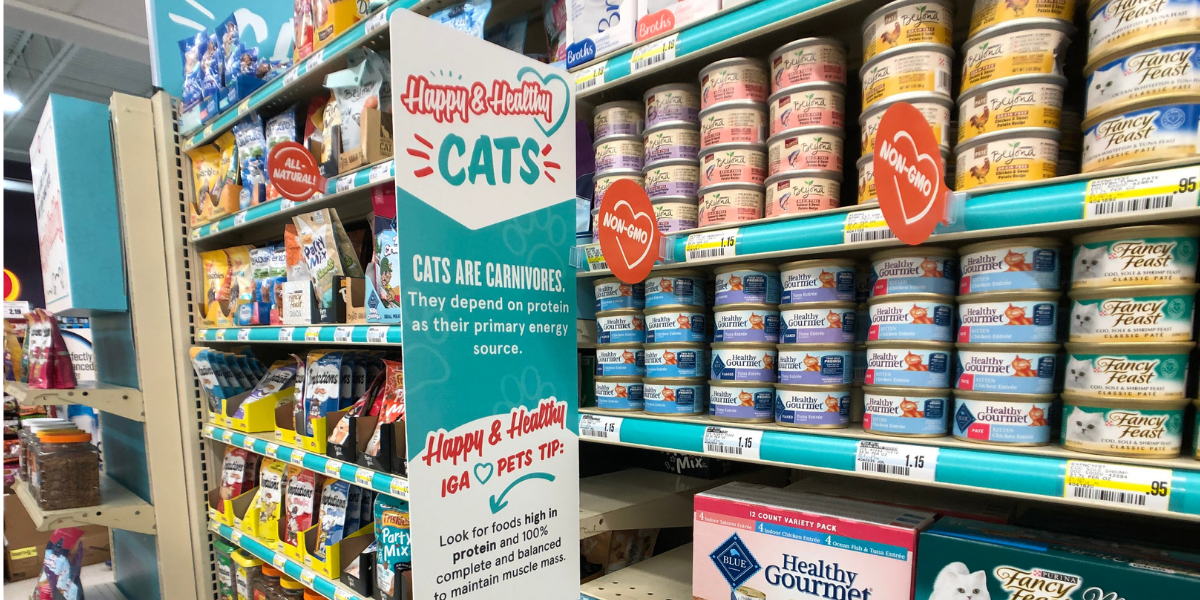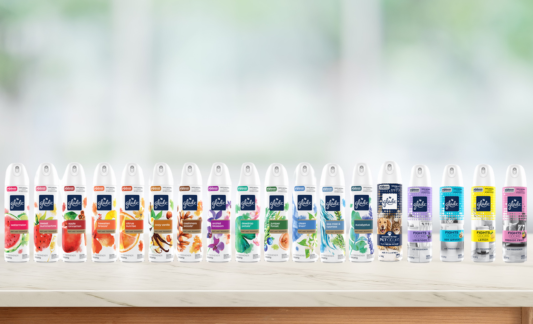Please do not participate in a Facebook scam about a $100 voucher. Facebook is working to have it removed.

4 min read
Restore the Shelf: Pet Aisle Assortment & Merchandising Tips
Written by IGA News
May 10, 2023
The pet category continues to grow, with $58.1 billion spent on pet food and treats in 2022 and a projected $62.7 billion to be spent in 2023, according to NielsenIQ data. But pet category growth was a challenge for independent retailers due to supply issues that started during the early days of the pandemic.
What happened? Steve King, president and CEO of the American Pet Products Association (APPA), explained at the Global Pet Expo Digital Access that many factors in the early pandemic impacted the category's supply disruption: the surge in pet adoptions, COVID worker safety protocols, worker shortages from illness or quarantining, and more.
Today pet food supply is much stronger than it has been, and Red Oval partner Nestlé Purina is confident in their ability to aid independent retailers in restoring their shelves to attract the much-sought-after pet category shopper. We spoke with Tiffany Kubal, category development manager at Nestlé Purina, about current pet category shopper trends and how independent grocers can move ahead with an optimal assortment.
Key Takeaways:
- 90% of pet trips are planned, so add in-store signage to advertise your pet aisle assortment and help with navigation
- Offer brand depth to help brand-loyal shoppers substitute flavors if needed
- Stock up on litter and treats, as they are strong subcategories with few supply issues
How has the pet category changed since 2021-22 as we have been emerging from the pandemic?
The pet department had been growing at a high rate leading up the COVID pandemic. Growth further accelerated during the pandemic with the change in work schedules and evolving owner relationships. Interactions with the pets in the home increased.
Growth has been driven by categories that are considered “indulgence” or “emotional connection,” which includes treats and wet pet food. While dry feeding will remain the staple, increased time spent with our pets had led to additional feeding/treating occasions. The unprecedented growth has driven increases in stock-up, pantry loading, and large package purchases.
What shopper trends are you seeing in the pet category in recent months?
The relationship people have with their pets continues to evolve. Driven by humanization, the pet parent views their pet as a part of the family. They feed following similar nutrition as when purchasing for their family or themselves. This has led to an increase of premiumization, driven by science, in the industry.
Top growth segments focus on nutritionally specific outcomes (weight management, high protein, aging benefits, etc.), clean label marketing, and elevated feeding and treating occasions.
For example, Nestlé Purina offers Purina ONE, a premium line with natural, high-quality ingredients to create nutrition that can lead to visible differences in your pet's health.
What visual merchandising tips do you recommend to independent grocers to cater to those shopper trends?
Since 90% of pet trips are planned, in-store pet aisle navigation and signage is helpful to drive awareness of the department. While almost every store has a pet department, the location in the store varies significantly. Navigation can include signage, interrupting colors, or even a dedicated endcap.
We collaborated with IGA to develop a pet signage kit to help retailers draw attention to their pet departments, which you can view and order here.
 The IGA Happy Healthy Pets Sign Kit installed in an IGA store.
The IGA Happy Healthy Pets Sign Kit installed in an IGA store.
Merchandising product based on price flow and interacting categories can also help drive trade-up and impulsive purchases. Here are some additional tips:
- Stock a variety of products that your customers are already shopping for (for example, if your biggest seller is premium, stock a variety of sizes in premium)
- Maintain a varied selection in all subcategories
- Reflect national trends in the category, like all-natural and meat as ingredient #1
- Vary assortment by life stages, from kitten or puppy to senior
What is a recommended assortment for single independent grocery stores to optimize sales? For a multi-store group of independents? Please consider product availability to our LDCs.
We have not observed significant product or brand substitutions despite industry-wide supply challenges. Having sufficient assortment in top brands is crucial to capturing the trip. While the shopper is likely to change flavors during an out-of-stock situation, they are not as willing to shop outside of their desired brand.
For example, a Purina shopper may switch from chicken to beef if their grocer is out of chicken-flavored pet food, but they are unlikely to buy a chicken-flavored pet food from a different brand. Therefore, depth within brands is more important than brand diversity in the grocery shopping experience.
Actual merchandising and assortment can vary greatly based on size, location, and competition. For more in-depth analysis, please reach out to your Nestlé Purina partner or Account Manager Kara Destro.
Based on what Nestlé Purina and the pet category have experienced in the last three years regarding the supply chain, what are the safest bets in product availability for your brand?
We have experienced significant improvements in litter and treats capacity. While case fill is not perfect, we are confident in our ability to supply these subsegments as we move forward.
We have confidence in supply and promotion in dog and cat treats and cat litter, including Beggin Strips, Busy Bone, Friskies Party Mix, and Tidy Cats Litter.
What do you see as the highest leverage opportunity for independents in Pet?
Having proper assortment/depth in brands will allow for substitution instead of leaving the store to shop elsewhere. This is important to the pet department as well as the total store due to the dollar spend pet owners bring to the retailer.
Playing on the emotional drive of the category as well as using informational signage will also help retailers become the top choice.
Winning with omni-shoppers (also known as hybrid shoppers who shop both online and in store) is an increasingly important strategy as the omni-shopper spends more dollars. As the population of omni-shoppers continues to grow, capturing these purchases is a key aspect to winning.
Retailers can keep these shoppers by developing easy transitions between the in-store shopping experience and online. For example, they can implement buy online, pick up in store services; curbside pickup; use third-party delivery platforms; and internal site development.
Previous Story
← Peet's Coffee Offers Merchandising Tips For Independents
You May Also Like
These Stories on Red Oval Roundup



No Comments Yet
Let us know what you think